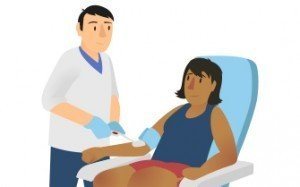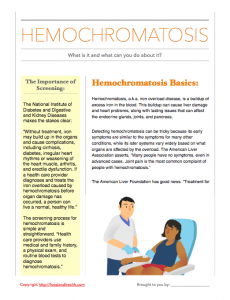July is Hemochromatosis Screening Awareness Month
July is Hemochromatosis Screening Awareness Month! Do you know what you need to know?What is Hemochromatosis? Hemochromatosis, a.k.a. iron overload disease, is a buildup of excess iron in the body. This buildup can cause liver damage and heart problems, along with lasting issues that can affect the endocrine glands, joints, and pancreas.(Members: Get more details about the 3 types of hemochromatosis in the post A Closer Look at Hemochromatosis).What Causes Hemochromatosis?A gene mutation (one that affects roughly 1 million people) usually causes hemochromatosis, though the simple presence of the mutation does not necessarily mean that the disease will develop. According to the Centers for Disease Control and Prevention (CDC), "Not all people with this gene mutation develop iron overload, and not all people with iron overload develop the signs and symptoms of hemochromatosis."Basically, people with hemochromatosis absorb more iron than their bodies need. Since there is no way for the body to get rid of excess iron, that iron builds up in the bloodstream, heart, liver, and pancreas. This buildup is called iron overload. As iron overload persists, the body's systems sustain lasting damage that can ultimately result in organ failure.If hemochromatosis is discovered early, the treatment can reduce damage and lighten the symptoms of the condition. If left undiagnosed, hemochromatosis can cause lasting issues and irreversible harm.Since July is Hemochromatosis Screening Awareness Month, now is the time to learn about getting screened.Why Get Screened?
Hemochromatosis, a.k.a. iron overload disease, is a buildup of excess iron in the body. This buildup can cause liver damage and heart problems, along with lasting issues that can affect the endocrine glands, joints, and pancreas.(Members: Get more details about the 3 types of hemochromatosis in the post A Closer Look at Hemochromatosis).What Causes Hemochromatosis?A gene mutation (one that affects roughly 1 million people) usually causes hemochromatosis, though the simple presence of the mutation does not necessarily mean that the disease will develop. According to the Centers for Disease Control and Prevention (CDC), "Not all people with this gene mutation develop iron overload, and not all people with iron overload develop the signs and symptoms of hemochromatosis."Basically, people with hemochromatosis absorb more iron than their bodies need. Since there is no way for the body to get rid of excess iron, that iron builds up in the bloodstream, heart, liver, and pancreas. This buildup is called iron overload. As iron overload persists, the body's systems sustain lasting damage that can ultimately result in organ failure.If hemochromatosis is discovered early, the treatment can reduce damage and lighten the symptoms of the condition. If left undiagnosed, hemochromatosis can cause lasting issues and irreversible harm.Since July is Hemochromatosis Screening Awareness Month, now is the time to learn about getting screened.Why Get Screened? The National Institute of Diabetes and Digestive and Kidney Diseases (NIDDK) makes the stakes quite clear. "Without treatment, iron may build up in the organs and cause complications, including cirrhosis, diabetes, irregular heart rhythms or weakening of the heart muscle, arthritis, and erectile dysfunction. If a health care provider diagnoses and treats the iron overload caused by hemochromatosis before organ damage has occurred, a person can live a normal, healthy life."In other words, early detection can make a serious impact on the severity of this condition.Who Should Get Screened?"Experts recommend testing for hemochromatosis in people who have symptoms, complications, or a family history of the disease" (source).What is the Screening Process Like?
The National Institute of Diabetes and Digestive and Kidney Diseases (NIDDK) makes the stakes quite clear. "Without treatment, iron may build up in the organs and cause complications, including cirrhosis, diabetes, irregular heart rhythms or weakening of the heart muscle, arthritis, and erectile dysfunction. If a health care provider diagnoses and treats the iron overload caused by hemochromatosis before organ damage has occurred, a person can live a normal, healthy life."In other words, early detection can make a serious impact on the severity of this condition.Who Should Get Screened?"Experts recommend testing for hemochromatosis in people who have symptoms, complications, or a family history of the disease" (source).What is the Screening Process Like? The screening process for hemochromatosis is simple and straightforward. The NIDDK explains, "Health care providers use medical and family history, a physical exam, and routine blood tests to diagnose hemochromatosis or other conditions that could cause the same symptoms or complications."Generally, two blood tests can determine whether a person has hemochromatosis, and both of those tests can be performed at a doctor's office. These tests are usually made up of a serum ferritin test and a transferrin saturation test. If there are high levels of iron indicated in these tests, doctors may request a test for the gene mutation that causes hemochromatosis. In severe cases, they may also order a liver biopsy.Unfortunately, "Hemochromatosis is rare, and health care providers may not think to test for this disease. Thus, the disease is often not diagnosed or treated" (source).What are the Symptoms of Hemochromatosis?Hemochromatosis can be tricky because its early symptoms are similar to the symptoms for many other conditions, while its later systems vary widely based on what organs are affected by the overload. The American Liver Association asserts, "Many people have no symptoms, even in advanced cases. Joint pain is the most common complaint of people with hemochromatosis."Despite the difficulties in nailing down a definitive list, here is a basic rundown of possible symptoms of hemochromatosis...
The screening process for hemochromatosis is simple and straightforward. The NIDDK explains, "Health care providers use medical and family history, a physical exam, and routine blood tests to diagnose hemochromatosis or other conditions that could cause the same symptoms or complications."Generally, two blood tests can determine whether a person has hemochromatosis, and both of those tests can be performed at a doctor's office. These tests are usually made up of a serum ferritin test and a transferrin saturation test. If there are high levels of iron indicated in these tests, doctors may request a test for the gene mutation that causes hemochromatosis. In severe cases, they may also order a liver biopsy.Unfortunately, "Hemochromatosis is rare, and health care providers may not think to test for this disease. Thus, the disease is often not diagnosed or treated" (source).What are the Symptoms of Hemochromatosis?Hemochromatosis can be tricky because its early symptoms are similar to the symptoms for many other conditions, while its later systems vary widely based on what organs are affected by the overload. The American Liver Association asserts, "Many people have no symptoms, even in advanced cases. Joint pain is the most common complaint of people with hemochromatosis."Despite the difficulties in nailing down a definitive list, here is a basic rundown of possible symptoms of hemochromatosis... Early Symptoms of Hemochromatosis:
Early Symptoms of Hemochromatosis:
- Abdominal pain
- Fatigue
- General weakness
- Joint pain
- Weakness
- Weight loss
Intermediate Symptoms of Hemochromatosis:
- Body hair loss
- Early menopause
- Elevated liver enzymes
- Impotence
- Loss of sex drive
- Missing periods
- Shortness of breath
- Unexplained weight loss
Advanced Symptoms of Hemochromatosis:
- Arthritis
- Changes in skin color (bronze or gray)
- Cirrhosis
- Constant abdominal pain
- Diabetes
- Heart failure
- Heart issues
- High blood sugar
- Irregular heartbeat
- Liver cancer
- Liver damage
- Severe fatigue
According to the CDC, "Although most people reach middle-age before they have symptoms of hemochromatosis, some people may have symptoms at a younger age."How is Hemochromatosis Treated? The American Liver Foundation has good news. "Treatment for hemochromatosis is simple, inexpensive, and safe."The first thing a doctor will typically do is draw blood, a process called phlebotomy. Starting with a pint of blood 1-2 times per week, the amount of blood drawn will depend on the severity of the iron overload. By taking blood out of the body, a doctor is also reducing the amount of iron in a person's system.Once iron levels have returned to normal (a process checked by more blood tests), a person can set up maintenance phlebotomy treatments every few months. Many blood donation centers offer free blood drawings for people with hemochromatosis. The CDC advises, "If you have hemochromatosis, you should have your serum ferritin level checked at least once a year. Doing so can help keep your iron level within the normal range and avoid the serious problems caused by too much iron."There are also dietary considerations.The NIDDK asserts, "Healthy people usually absorb less than 10 percent of iron in the food they eat. People with hemochromatosis absorb up to 30 percent of that iron. People with hemochromatosis can help prevent iron overload by eating only moderate amounts of iron-rich foods, such as red meat and organ meat, avoiding supplements that contain iron, [and] avoiding supplements that contain vitamin C, which increases iron absorption."People with hemochromatosis should take steps to prevent liver damage as well, which may mean reducing or completely avoiding alcohol consumption.Remember, "The treatment’s effectiveness depends on the degree of organ damage. For example, treating hemochromatosis can stop the progression of liver damage in its early stages and lead to a normal life expectancy. However, if a patient develops cirrhosis, his or her chance of developing liver cancer increases, even with phlebotomy treatment. Arthritis usually does not improve even after phlebotomy removes extra iron" (source).References and Links for More Information:
The American Liver Foundation has good news. "Treatment for hemochromatosis is simple, inexpensive, and safe."The first thing a doctor will typically do is draw blood, a process called phlebotomy. Starting with a pint of blood 1-2 times per week, the amount of blood drawn will depend on the severity of the iron overload. By taking blood out of the body, a doctor is also reducing the amount of iron in a person's system.Once iron levels have returned to normal (a process checked by more blood tests), a person can set up maintenance phlebotomy treatments every few months. Many blood donation centers offer free blood drawings for people with hemochromatosis. The CDC advises, "If you have hemochromatosis, you should have your serum ferritin level checked at least once a year. Doing so can help keep your iron level within the normal range and avoid the serious problems caused by too much iron."There are also dietary considerations.The NIDDK asserts, "Healthy people usually absorb less than 10 percent of iron in the food they eat. People with hemochromatosis absorb up to 30 percent of that iron. People with hemochromatosis can help prevent iron overload by eating only moderate amounts of iron-rich foods, such as red meat and organ meat, avoiding supplements that contain iron, [and] avoiding supplements that contain vitamin C, which increases iron absorption."People with hemochromatosis should take steps to prevent liver damage as well, which may mean reducing or completely avoiding alcohol consumption.Remember, "The treatment’s effectiveness depends on the degree of organ damage. For example, treating hemochromatosis can stop the progression of liver damage in its early stages and lead to a normal life expectancy. However, if a patient develops cirrhosis, his or her chance of developing liver cancer increases, even with phlebotomy treatment. Arthritis usually does not improve even after phlebotomy removes extra iron" (source).References and Links for More Information:
- Hemochromatosis from the American Liver Association
- Hemochromatosis from the National Institute of Diabetes and Digestive and Kidney Diseases
- Hemochromatosis: Also Called Iron Overload Disease from the U.S. National Library of Medicine, a service of the National Institutes of Health
- Hemochromatosis (Iron Storage Disease) from the Centers for Disease Control and Prevention
There's more in the Nutrition Education Store! Check out these top resources for July...

 But wait, there's more! Here's a PDF handout that outlines the basics of hemochromatosis and underlines the importance of early screening. Get your copy now!
But wait, there's more! Here's a PDF handout that outlines the basics of hemochromatosis and underlines the importance of early screening. Get your copy now! Did you know that members get even more? Drop by the post A Closer Look at Hemochromatosis for a detailed guide to the 3 basic types of hemochromatosis. There's tons of research, links to more information, and a free handout!
Did you know that members get even more? Drop by the post A Closer Look at Hemochromatosis for a detailed guide to the 3 basic types of hemochromatosis. There's tons of research, links to more information, and a free handout!


